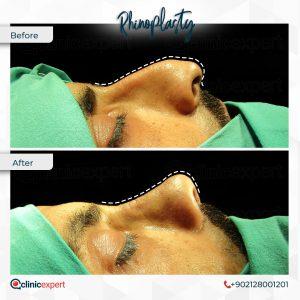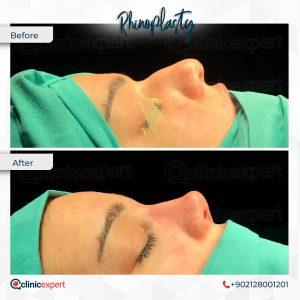Closed vs Open Rhinoplasty
Deciding between open and closed rhinoplasty can be a daunting task when seeking the best results for your appearance. There are two different approaches when it comes to the art of reshaping the nose: open and closed rhinoplasty. Open rhinoplasty allows for advanced techniques such as tissue grafting and may be beneficial for revision cases. On the other hand, closed rhinoplasty excels in straightforward procedures. However, you must keep in mind that the surgeon’s skill and expertise are the key determinants of a successful outcome. Both techniques can yield exceptional results, and any temporary differences in recovery or incision visibility become irrelevant in the long run.
What Is Open Rhinoplasty?
Open (external) rhinoplasty, is a surgical technique used to reshape and enhance the appearance of the nose. In this approach, the surgeon makes a small incision on the columella (the strip of skin between the nostrils). He/she may also create additional incisions inside the nostrils. These incisions allow for direct access to the underlying nasal structures.
Once the incisions are made, the surgeon lifts the skin and soft tissue covering the nose. Open rhinoplasty provides a clear view of the nasal framework. This visibility enables precise modifications to the cartilage, bone, and other tissues of the nose. The surgeon can reshape the nasal structures, refine the tip, narrow the nostrils, or correct any asymmetries or deformities.
Pros of Open Rhinoplasty
- Enhanced Visibility: The open approach provides a direct and comprehensive view of the nasal structures. It allows for more precise modifications and corrections.
- Complex Procedures: Open rhinoplasty is particularly advantageous for complex cases that require extensive reshaping or reconstruction of the nose.
- Tissue Grafting: It allows for the use of tissue grafts, such as cartilage or bone, to reshape and augment the nose.
- Revision Rhinoplasty: Open rhinoplasty is often preferred for revision surgeries, as it allows the surgeon to access and address previous surgical alterations more easily.
Cons of Open Rhinoplasty
- Visible Incision: The incision made on the columella results in a small scar. It typically fades over time. Still, it may take several weeks or months to become less noticeable.
- Longer Recovery: Open rhinoplasty generally involves more extensive dissection and manipulation of the nasal tissues. As a result, it can lead to a longer recovery period compared to closed rhinoplasty.
- Potential Swelling: The additional tissue manipulation in open rhinoplasty may result in increased swelling, especially in the nasal tip area.
- Higher Risk of Alar Base Modification: Some patients may require alar base modification, which involves making incisions in the nostril area, leading to potential visible scarring.
What Is Closed Rhinoplasty?
Closed (endonasal rhinoplasty), unlike open rhinoplasty, involves external incisions. Closed rhinoplasty is performed entirely through incisions made inside the nostrils.
During closed rhinoplasty, the surgeon accesses the nasal structures by making incisions within the nostrils. This approach eliminates the need for an external incision on the columella. Therefore, resulting in no visible external scars. Through the internal incisions, the surgeon gains access to the cartilage, bone, and soft tissues of the nose.
The surgeon then carefully manipulates and reshapes the nasal structures to achieve the desired results. They may remove or reposition cartilage, trim excess bone, refine the nasal tip, or correct any asymmetries. The closed technique allows for modifications to the internal structures while maintaining the natural support and structure of the nose.
Closed rhinoplasty is often preferred for straightforward cases that require less extensive modifications. It can be suitable for patients who desire minor changes to their nasal appearance, such as refining the tip, reducing a hump, or addressing slight asymmetry.
Pros of Closed Rhinoplasty
- No Visible External Scarring: This can be particularly appealing to individuals who are concerned about the potential visibility of surgical incisions.
- Reduced Swelling and Faster Recovery: Closed rhinoplasty typically involves less extensive dissection and manipulation of the nasal tissues compared to open rhinoplasty. As a result, it may lead to reduced swelling and a faster recovery period. The decreased tissue trauma can contribute to a quicker return to normal activities for patients.
- Preservation of Nasal Support: The closed technique allows the surgeon to make modifications and refinements to the nasal structures while maintaining the existing support and structure of the nose. This preservation of nasal support can be advantageous in maintaining the long-term stability and function of the nose.
- Suitable for Straightforward Cases: It can be an effective technique for addressing concerns such as a dorsal hump reduction, minor tip adjustments, or correction of slight asymmetry.
- Potentially Shorter Operating Time: The closed approach may require less surgical time compared to open rhinoplasty since it does not involve the additional step of creating an external incision and lifting the nasal skin. This can be beneficial in terms of anesthesia duration and overall surgical efficiency.
Cons of Closed Rhinoplasty
- Limited Visibility: It may make certain complex or extensive modifications more challenging to perform compared to open rhinoplasty.
- Technical Limitations: It can be more challenging for the surgeon to make precise changes to the nasal tip or address complex nasal deformities that require extensive restructuring.
- Difficulty in Correcting Certain Issues: Closed rhinoplasty may be less suitable for addressing certain nasal issues, such as significant asymmetry or complex structural abnormalities that require extensive reconstruction. In such cases, an open rhinoplasty approach may provide the surgeon with better access and control for achieving the desired results.
- Potential for Increased Surgical Time: While closed rhinoplasty may generally involve a shorter operating time compared to open rhinoplasty, it’s important to note that in some cases, it can take longer to achieve the desired modifications using the closed technique. The complexity of the procedure and the surgeon’s experience can impact the duration of the surgery.
- Limited Accessibility for Revision Surgery: Revision cases often require more extensive modifications. An open rhinoplasty approach might be more suitable for addressing the previous surgical alterations.
Closed Rhinoplasty in Turkey
Our surgeons at the ClinicExpert Hospital are proficient in both approaches, ensuring that you receive personalized care tailored to your needs. With us, you can rest assured that you’ll achieve stunning results that enhance your natural beauty. You can contact us right away if you would like to learn more about close rhinoplasty in Turkey.



